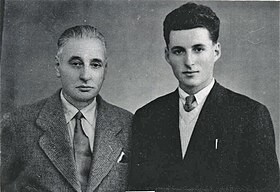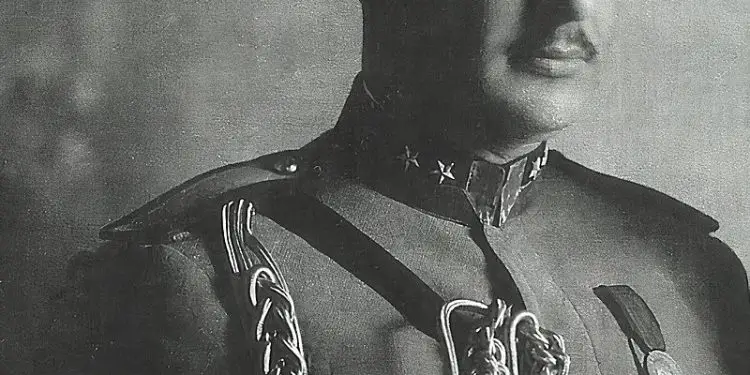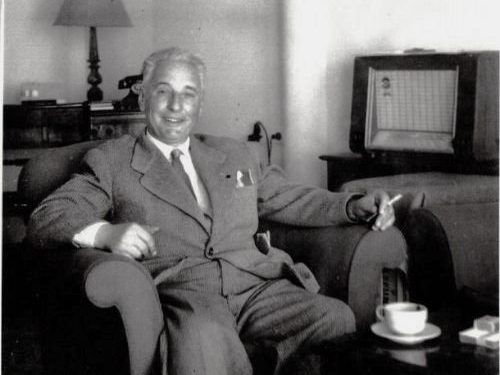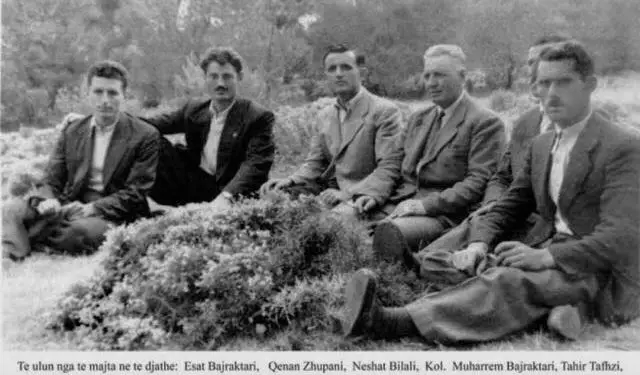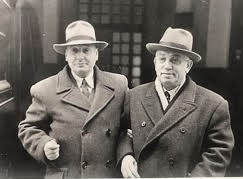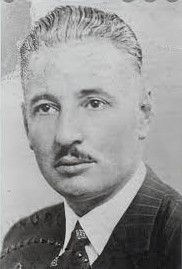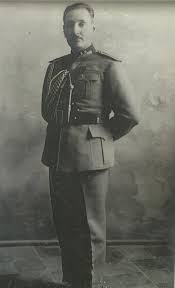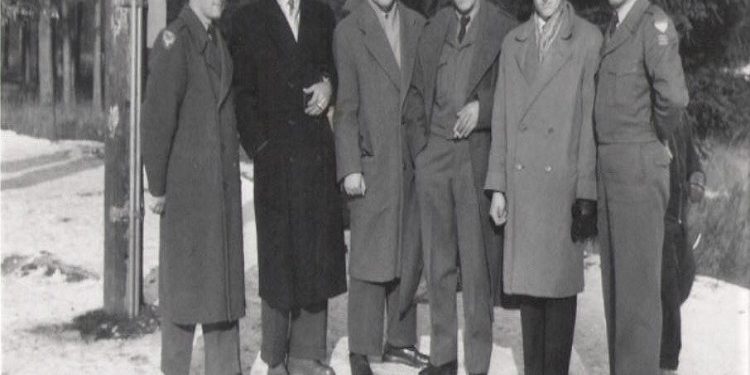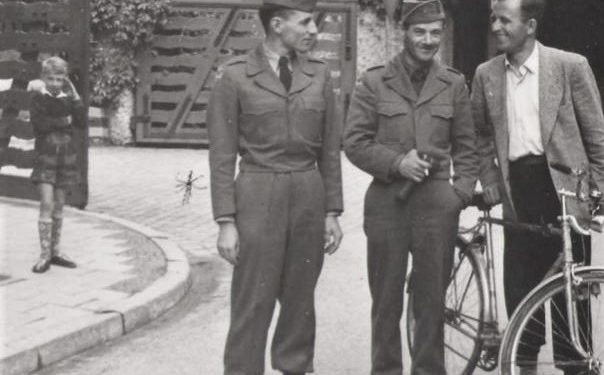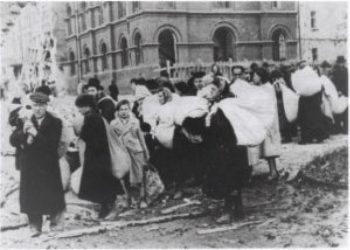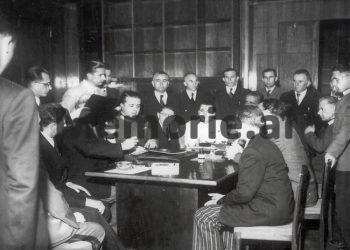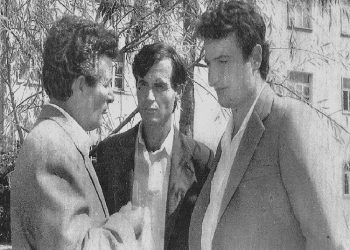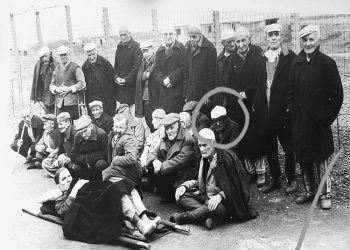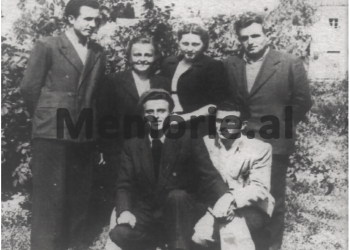By Petrit Palushi
Memorie.al / The punishments of the communist regime against the family and the entire tribe of Muharrem Bajkaktar were severe, even today – on the limits of the unimaginable. The persecution of Muharrem Bajraktari, before the tragic year of 1946, began with the issuance of Enver Hoxha’s order, on August 26, 1944, for the Headquarters of the First Division to provoke Muharrem Bajraktari and liquidate him: “… or e force Muharrem to submit, or unmask him and pursue him to capture him, according to the situation that arises”! (Book “Enver Hoxha’s anti-national policy”, p. 322, “Eurorenaissance”, 1996). Even the testimony of Manush Mufti in the Plenum of Berat is a complete confirmation following the drastic effort that was made to implement Enver Hoxha’s order:
“For Muharrem Bajraktar, when we heard that he had started to fight the Germans, we despaired that this unmasked and uncompromised element would gain influence and pull the crowds with it. After an attempt was made to introduce him to the Front, he refused but wanted to fight outside the Front. This dangerous attitude strengthened our conviction to eradicate it. His disappearance was necessary”! (Cited material, pp. 92-93).
In June 1946, exactly when Colonel Muharrem Bajraktari was being pursued by the special units of the Pursuit Forces, in the “National” Cinema (Tirana), the farce trial was organized against 37 opponents of the repressive communist regime that was being established in Albania. Among the accused was Musine Kokalari, who, among others, was also accused of collaborating with fugitives, such as, for example, the well-known nationalist Muharrem Bajraktari:
– “Why, Bajraktari is not a war criminal”?
– “No”, – says the accused.
The people shout: Traitors, criminals! You are partners with him. (Newspaper “Bashkimi”, June 27, 1946, p. 2) The trial was held in the improvised courtroom, in the “Nacional” Cinema, while Muharrem Bajraktari, whose name was mentioned in that room, on those days, was in Lumë, surrounded almost hermetically, by the Pursuit Forces. The noblewoman Musine Kokalari, in the courtroom, in addition to trying to defend herself and her ideas, was also publicly defending Muharrem Bajraktari. Her words were an open reaction to the dictatorship that was being installed…! So, the spring of 1946 was tragic for Muharrem Bajraktar’s family.
This family had several deaths in a row; were non-consecutive deaths or, as they can be called differently, as; “death out of order”. The forms of death, as well as the places where the bodies of the dead were thrown, were wrapped in many puzzles, which, even after more than 70 years, have still remained unsolved and, as soon as the impression is created that they come to light a little bit, still everything sinks into other mysteries.
The members of his family, especially in the years 1944-1946, along with him, remained in constant travel and, any peace of the family, in any case that appeared, or was expected to appear, remained few and far between temporary. After the summer of 1944, the family members left one by one, never to gather together again.
In 1946, two of the family members, Ibrahim and Hamdi Bajraktari (who, because of the war, had stopped their studies in Italy and had returned to their homeland), found some peace, but close, a peace that can only be gained by the dead and that could follow that, the dead (more precisely, the murdered), now and again, would escape persecution, anxiety, but on the other hand, the part of the family that had remained alive, apart from the pressure and persecution of the state the post-war regime, it would constantly struggle, out of concern for its lost ones, which meant that at the height of its prosperity, the family was split in half, more than half alive and the rest, dead.
To create the impression that the head of the family, Muharrem Bajraktari, would live a long time, almost close to 100 years (He died in Belgium, in 1989), as a kind of “compensation” for another part of the family, which had not been able to exceeded the average age of half a human’s life. The movement or travel of the family members, as well as of the people closest to her, prevailed almost all the time. In the first two years after the war, Muharrem Bajraktari, the parent of six children, moved along the River, while three of them stayed with him: Ibrahimi, Hamdiu, Esati, as well as his brother, Bajram.
In 1945, Muharrem Bajraktar’s wife Nazifja with Genci and Lirije were interned in Berat, as well as Bajram Bajraktar’s wife Huma with their son, Nezir, who had not yet reached puberty. Nazifja with Genci and Lirije remained in exile and she died there in 1951, in the hospital of Gjirokastra. Ibrahimi disappears wounded after the siege of Shpatza and a day later, his brother Hamdiu is executed wounded, but without trial, a murder which was commented on for a long time and continues to be commented on even today, but nevertheless, the comments enter the well of some versions.
THE DISAPPEARANCE OF IBRAHIM BAJRAKTARI
The enigma in this case is more obvious, apart from the fact that it is considered extinct and in all cases it is considered extinction, which is part of those without even a sign. So, after the end of the siege of Shpatez (April 1946), it has always been considered lost. There was a lot of talk about this loss after his disappearance, especially in the first two or three years, and comments revived again after 1990. Again, there are many versions.
First version:
Ibrahimi was injured and in order to escape the Pursuit Forces, he crossed Drin e Black, but he died from multiple wounds, it is not known where. Later, residents of Surroi took the body of the deceased from the many wounds and buried it somewhere, but it is still unknown where, which they kept extremely secret. The version above is still hazy, a version shrouded in mystery. If it had happened like this, that is, according to the first version, such a thing, at least by now you would have learned.
This is due to the fact that, after the overthrow of the communist regime, many people who had relatives in prisons and who were sentenced to be shot, for political reasons, started the odyssey of searching for the graves, where the bodies of the shot were thrown. Thus, if something was known about Ibrahim’s grave, such a thing would have been learned, since people avoided the fear of punishment that existed before that, if they knew such a thing and did not tell it, and at the same time if found out, there would be serious consequences.
The testimony of Bajram Bajraktari must be closer to the truth: “Ibrahim Bajraktari was lost without a trace, but of course he died, otherwise we would have found him and thrown him into Drin, otherwise we would have investigated where he died. When the fighting started he said: I wasn’t injured, I will fall to Drini” (Bajram Bajraktari “Promemorje”, p. 80) However, B. Bajraktari’s explanation is the same only in two points, with the explanations or guesses of others.
He absolutizes Ibrahim’s death, which he still connects with the latter’s premonition that; if he was injured, it would fall to Drini. We noted that; B. Bajraktar’s explanation is the same only in two points, with the explanations or conjectures of others. First, Ibrahimi was wounded and secondly, he was thrown into Drin and drowned. When we say that Bajram Bajraktar’s testimony may be closer to the truth, we also start from the fact that it happened to him during the siege of Shpatza.
Second version:
On the other hand, another version came to light, according to the confession of the doctor, Zeqir Seferi:
“In the summer of 1946, there were rumors that Muharrem Bajraktari would leave the country. But before he left, he met Selim Durrë in Buzmadhe and told him: I’m leaving, but not for long. I left you a bequest: Take care of Ibrahim, because he came out wounded from Shpatze and we don’t know where he is. We have looked for him everywhere, but we have not found him. Get interested as much as you can, among friends! Ban what is possible! Selim Durra, who was very interested, had asked friends and kind people, but had not learned anything. These things, Selim Durra himself told me, many, many years ago” (Testimony taken in 1997).
The above evidence clouds the issue again, but at the same time sheds light on something else: it confirms the fact that; Miharrem Bajraktari knew that his son had come out injured from Shpatza’s attempt, but he also knew that he was more alive than dead, otherwise, he would not have turned to Selim Durra.
On the other hand, Bajram Bajraktari mentions in his notes a premonition of Ibrahim and with that, as if confirming the latter’s death. However, this is not very reliable. What Muharrem knew about his son, Ibrahim, Bajram also knew, since they stayed together for a few more months, until the trip to Greece, but on the way, Bajram was caught injured? It is worth believing that Bajram Bajraktari, knowing the same things about Ibrahim as Muharrem Bajraktari, that is, thinking him still alive, in his testimony, tries to distort the truth, i.e., if you will be alive somewhere Ibrahimi, the information he brought, he could be done exactly, to divert the attention of the Pursuit Forces.
Meanwhile, one thing is known for sure; that the loss of Ibrahim and the execution of his brother, Hamdi, happened in the space of two days between. Meanwhile, the explanations of Bajram Bajraktari’s son, Nezir that after 1990 many were searched and asked about Ibrahim’s grave, but no positive answer was received, leaving all the versions hazy, except for one clear point: that of the loss (disappearance) of Ibrahim Bajraktar: The information of that time also contains inaccuracies. Thus, in information from N/Bicaj Prefecture, from September 1946, it is mentioned about the murder of Ibrahim Bajraktar: “… the eldest son of Muharrem, Ibrahimi, was also killed in Shpatëz, as according to the information, it must be true” (Kukës Archive, p. 51, File No. 8, Year 1946).
THE DROWNING OF HAMDI BAJRAKTAR
In Shpatza’s attempt, Muharrem Bajraktar’s other son, Hamdiu, was also injured. According to a testimony of Nezir Bajraktar: “We wounded Hamdi in Shpatëz and we killed Imer Miftar, they had killed him that night in Bicaj. That same night, Hamdi was shot or strangled, God only knows! They put him in the grave the next day (I’m saying it’s a grave, they told me better – they dug a hole and put him in!). They put them in a pit in Mbaskodra, in Zalli i Bardhë. Qazim Halili from Cana told me, 30 years ago, that he knew where the bodies of Hamdi and Imer Miftari had been put.
When the time came for this work, together with one of our cousins, Korab Bajraktar, we went and got Qazim Halil and he gave us the place. If we stay crooked and speak straight, I say that Hamdi was strangled, they took his soul with difficulty, and that’s how he spoke many times. When we took out the bones of Hamdi, and reburied them in the street, in the Dome, we noticed that the upper bones had no markings, while the bones of the left leg were markings, where he spoke, that he had taken it the wound in Shpatez”.
More or less the same testimony of Ismail Hajdari:
“The son of Bajraktar was drowned at night. The soldier, who was guarding him at the door of the cave in Cane, immediately took out this chatter, where they had tied him up and tied him up. Since that time, we have known each other and have often talked to each other. The truth is that they drowned him at night, because the word does not come out in vain”. (Evidence taken in 1997) Still worth arguing about. In the archival documents, it is learned that Hamdi Bajraktari was shot by order of Beqir Ndou, the head of the People’s Protection Section.
Archival document:
“In the last attempt with Muharrem Bajraktari, where his son was injured, the officers who were there have shown themselves to be quite weak, based on the information provided by the friends of the organization. On the other hand, we note that the son of Muharrem, who was caught wounded, after being interrogated, by order of the head of the People’s Protection Section, Kuka, Comrade Beqir Ndou, was killed. This is considered conspiratorial. Comrade Beqir Ndou gave the order to shoot, for these reasons.
Because the morale of the partisans had fallen, because the opinion of the masses in the effort that nothing can happen to Muharrem and his son, because he has connections with the people here, and others” (Information of the Regional Committee of the PKSH (Kukas) for KPSH Central Committee – Kukës Archive, p. 26, File No. 20, Year 1946)
At the same time, in the above document, it is learned that everything was kept conspiratorial and the shooting was carried out (as it is written, only by order and without a trial), to raise the morale of the partisans and to spoil the widespread opinion; that Muharrem and his son could not suffer anything. It is highly believable that Hamdi Bajraktar was strangled at night, but even if his shooting happened, it still contains a truth inside: the annihilation of Ibrahim Bajraktar.
It is also seen that; not even the slightest care was taken to send Hamdi Bajraktari to the hospital to recover and then be brought to trial; there seems to be a rush to clear the accounts as soon as possible. But let’s go back to another testimony, when Ibrahim Bajraktar was brought to Bicaj.
Testimony of Sami Doci:
“I remember very well, it was April 1946, and it was just beginning to open. I say that you should have started with leaf hatching, because the hazel had taken out an incomplete leaf. I was in the fifth grade. At that time, we taught at the Sula Hoxha tower in Canaj. It must have been the time of the long break, around 10:30 there. We drank water from Kroi i Verrijshte. With all my peers, we went to the Lama of Bilal that was the name of the Lama of Hali Aga. The place there was a corner down. We have been in hill. The Pursuit Forces (they were called partisans even then), were staying at the Shemsi Medi’s cave.
Its door communicated with Kroi i Verrishta. We were children and curious, as children are. Two people, they broke up with the trio. Trina was woven with hazel twigs. They left the trina for land and three or four partisans immediately surrounded him as he was staying in the trina. Later we found out that the one in the trinity was Hamdiu, the son of Muharrem Bajraktari. They hurt him. As soon as I opened and closed my eyes, they caused another man to be tied to the mule, so that his hands were hanging. You were killed. Later I would find out that the murderer was Imer Miftari. After a while, we went back to school.
When we finished school, we found out that he was injured, that he had been moved from the yard of the Shemsi Medi house to another house, 50 meters from there. You were injured in my mind. He was wearing an elegant blouse and as soon as they had left the trine on the ground, he lifted a little of the trine and when he saw us, he gave the children a hand. At that time, the partisans surrounded it and we have not seen it since. As it seems, I now judge, that he thought that you had no more suffering.
I said that they had moved Hamdi with another ship, about 50 meters from there. By asking each other, word by word, we found out where they had put him. We approached the hole and the door was guarded with a rifle, only one partisan. They didn’t let us in, except for Cen Dom, who got in and left immediately. The next day we found out that Hamdina was taken out of the cave dead”. (Evidence taken in January 1998).
INACCURACY IN THE BOOK OF URAN BUTKA!
In the book “Mukja – chance of union, pledge of betrayal” (Uran Butka, pg. 28, Tirana 1998), where it is written that; “The communist forces of the 5th Brigade fell to the forces of Muharrem Bajraktar, when they were organized in the war against the Germans. So, instead of uniting against the occupiers, bloody efforts took place between Albanians, brothers of the same blood, where 28 innocent partisans were killed, as well as many fighters of Muharrem Bajraktar, among them his two sons were also killed. there is an inaccuracy. Ibrahim and Hamdi Bajraktari were not killed during the war, but both were wounded in Shpatëz (1946). After that, Hamdiu disappeared and was never told about his fate, while Hamdiu was brought to Bicaj and drowned there.
THE EXECUTION OF BAJRAM BAJRAKTAR
In August 1946, they escaped to Greece; Muharrem Bajraktari, Bajram Bajraktari and Esat Bajraktari, but on the way, Bajram Bajraktari was injured (a very well-known person, with a high education in Italy) According to the testimony of the participant of that trip, Neshat Bilali:
“I remember Bajram Bajraktar well, on the first day of the effort with the Macedonian army (September 6, 1946). On the second day of the fight, I don’t remember. The second day of fighting (September 7, 1946) was terrible. After this fight, we traveled almost scattered and with some people who had escaped, we met only in Greece. Bajram Bajraktari was separated from the headquarters during the battle on the second day of the war and we have not seen him since.
We thought of killing him. About a year later, Muharrem Bajraktari learned from an Englishman that Bajram Bajraktari was in Skopje prison. Later, Bajram from Skopje was taken to Albania and shot, in September 1949. Bajram Bajraktari, very soon made a name for himself. I’ve known him since I was young, when he used to come back to his home during summer school holidays, and often came to our home as well. We were the godfather with their backs. Personally, I had a lot of sympathy for him, because he was a loving, respectful, wise man. He went to school outside the country, in Italy.
He was an admirable man. He was also distinct when he spoke. At that time, everyone said that he was among the smartest and most intellectual people, among the Lumjans who studied outside the country. He often told me that; only democracy can save our country, but still Albania is taking it for granted and the dictatorship is trying to capture it. He said that he dreamed of a democratic ethnic Albania. He had great sympathy for France and often said that France is the country of culture and civilization”.
TESTIMONY OF HUME, WIFE OF BAYRAM BAJRAKTAR:
“We found out that Bajram had been shot. With my relatives, we went to Shkodër and presented ourselves at the Department of Internal Affairs. I told them: We have come to take Bajram’s body and bury it. One of the officers said: We will not give the body. The state has laws and we have laws, even for the dead. Boll, how did you find out, how we shot him. He has been an enemy and do not beg more. Who did he turn to; at least let’s find out where he was buried?! Not even God could help me! I had all the doors wrong. I returned to the house, tied the scarf around my neck and barely raised my only son, Nezir. When Democracy comes, Neziri is interested in his father’s grave, but he hasn’t found the grave”. (Evidence taken in 1997). Memorie.al




